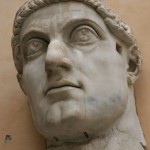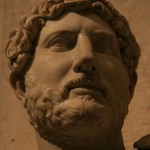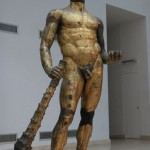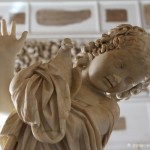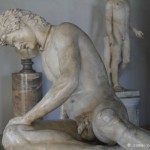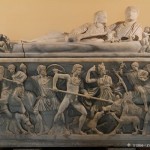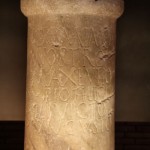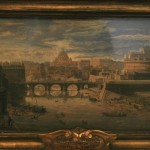In Italian: Musei Capitolini
The Capitoline Museums are one of the most significant museums in Rome, particularly renowned for their collection of ancient works, diverse and rich in masterpieces. They offer an immersion into the art, culture, and civilization of ancient Rome. For those most interested, it’s easy to spend at least half a day there.
Located around the Capitoline Square, they occupy the New Palace (Palazzo Nuovo), the Palace of the Conservators (Palazzo dei Conservatori), and the Senatorial Palace (Palazzo Senatorio).
The visit to the Capitoline Museums ranks number 14 in our Top 30 things to see in Rome.
Collections of the Capitoline Museums: Exceptional Sculptures and Paintings
The sculpture collection began in the 15th century, and in 1734, Clement XII opened the world’s first public museum in the Palazzo Nuovo. The Pinacoteca in the Palace of the Conservators was inaugurated in 1749.
The Palazzo Nuovo houses Greek and Roman sculptures, such as busts in the Hall of Philosophers or the Hall of Emperors on the first floor.
The Palace of the Conservators, which hosted the city’s magistrates in the Middle Ages, features rooms adorned with colorful frescoes and preserves masterpieces like the Medusa by Bernini or the colossal statue of Constantine. On the second floor, the Pinacoteca displays paintings by great artists such as Caravaggio, Van Dyck, Veronese, Tintoretto, and more.
Gallery of Exemplary Works from the Capitoline Museums
- Constantin
- Hadrian Bust
- Hercules Bronze
- Bernini’s Medusa
- Sculptures
- Galatians dying
- sarcophagi
- Milestone via prenestina
- Pinacoteca
Practical Information: Hours and Access to the Capitoline Museums
Musei Capitolini
Piazza del Campidoglio 1 – 00186 Roma
Open Tuesday to Sunday from 9:30 AM to 7:30 PM generally (last entry at 6:30 PM)
Open December 24 and 31 from 9:30 AM to 2:00 PM
Closed on Mondays, January 1, May 1, and December 25
Ticket price (museum entry with current exhibition, as of 03/01/2025): full €21, reduced €13.50
Capitoline Card price (valid for 7 days), Capitoline Museums + Centrale Montemartini: full €15.50, reduced €11.50
Audioguide price: €6, for children: €4 (recommended age: 6 to 12 years).
Resources for Further Exploration
- Official website: www.museicapitolini.org/en
- The Capitoline Museums on rome-roma.net, visit, photos.
- Wikipedia page
How to Reach the Capitoline Museums: Map
If you see this after your page is loaded completely, leafletJS files are missing.
Suggested Guided Tours and Tickets
FAQ and Tips for Visiting
What are the most interesting objects to see at the Capitoline Museums?
Main Works
- Capitoline She-Wolf (Lupa Capitolina): Bronze statue symbolizing the founding of Rome, likely dating to the 5th century BC.
- Equestrian Statue of Marcus Aurelius: Famous bronze statue, dating from 161–180 AD.
- Bernini’s Medusa Bust: Marble bust by Gian Lorenzo Bernini, a remarkable Baroque work.
- Dying Gaul: Marble statue, a Roman copy of a Greek original, depicting a wounded barbarian.
- Mosaic of the Doves: Roman mosaic from the 2nd century BC, renowned for its beauty and detail.
Other Essential Works
- The Spinario (Boy with Thorn): Bronze statue of a boy removing a thorn from his foot, dating to the 1st century BC.
- The Camillus: Bronze statue, one of the museum’s foundational pieces, dating to the 1st century BC.
- Boy with Goose: Marble statue of a boy with a goose.
- Statue of an Old Drunken Woman: Marble statue from the 1st century AD, strikingly realistic.
- Colossal Statue of Constantine: Reconstructed from fragments in the courtyard (free access).
- Bust of Emperor Hadrian: Marble.
- Bust of Emperor Caracalla: Marble.
Are there remains of ancient Capitoline buildings in the museums?
Yes:
- The Tabularium: Built in the 1st century BC, this structure served as the public archives for the Roman state. Integrated into the museum complex, its imposing facade faces the Roman Forum, offering a superb view. It connects to the gallery linking the two main palaces of the museum.
- Remains of the Temple of Jupiter Capitolinus: The foundations and podium of the temple, one of the largest Tuscan temples ever built, are visible, with gray tuff blocks located mainly behind the Palazzo dei Conservatori.
- Ancient Roman Bas-Reliefs: Fragments, including remains of the tomb of Publius Aelius Gutta Calpurnianus, a charioteer from the 2nd century AD, are reassembled outside.
- Other Possible Remains: It’s likely that additional fragments of ancient buildings, such as walls or architectural elements from the Area Capitolina (the sacred area surrounding the temple), are present.
How to Reach the Capitoline Museums?
The nearest metro station is Colosseo (Line B), a 15-minute walk away. Prefer the bus to reach Piazza Venezia, right nearby.
Is there a café/restaurant on site?
Yes, a café offers snacks and drinks.







